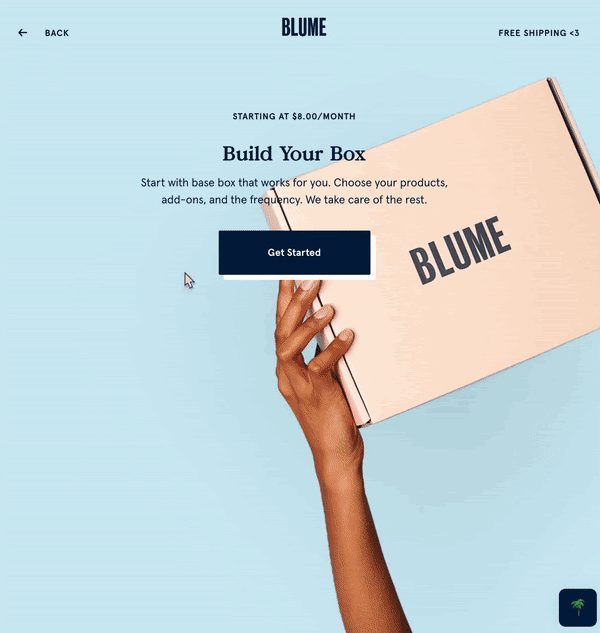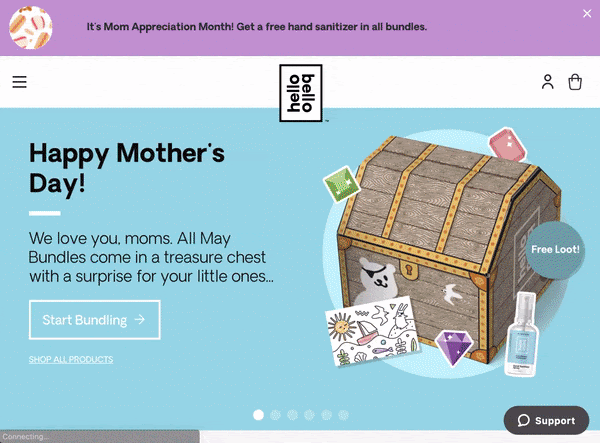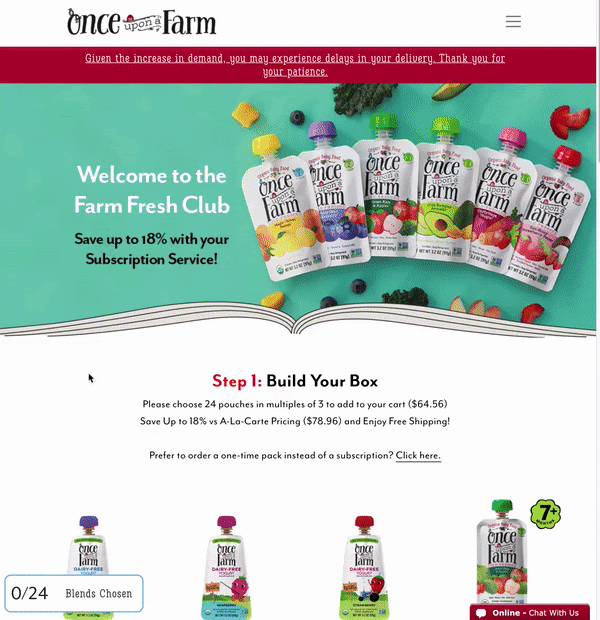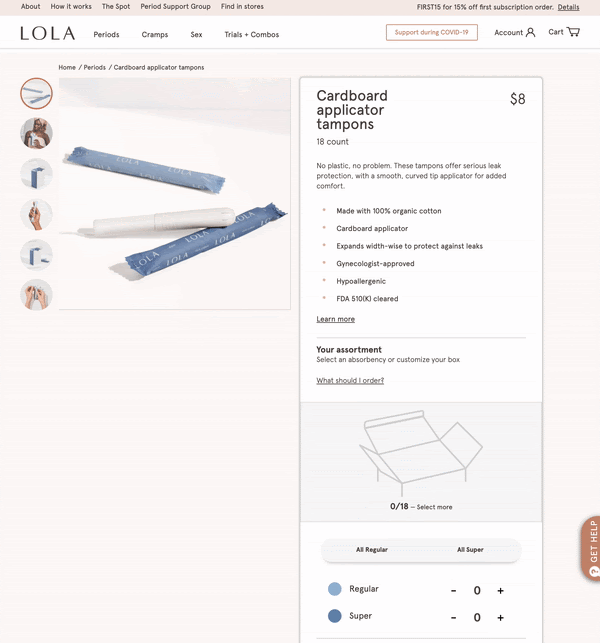Think about a product bundling scenario you’ve likely encountered frequently. Perhaps something like,
“I’ll have a cheeseburger and fries.”
“Would you like to add a soda for only $1 more?”
Product bundling is all around us. From the combo of complementary products at the drive-thru to the cable TV sports package, we’ve grown accustomed to bundling multiple products in everyday life. In the ecommerce world, product bundling is a versatile technique to increase your average order value, annual revenue, move inventory, and provide a better customer experience.
The benefits of product bundling
Product bundling benefits both the consumer and the merchant in various ways. For the merchant, adding more items to a single checkout grows average order value (AOV). Bundling a group of best-selling products increases the likelihood of your customers getting exactly what they need, therefore extending the amount of time they stay subscribed and ultimately, increasing lifetime value (LTV). Not to mention all the possibilities of perfecting the customer experience by allowing your customers to bundle products and purchase exactly what they want when they want.
Price is obviously the largest benefit for your consumers. Bundled products are generally cheaper than buying them individually so consumers feel they are getting better value but getting a lower price. Additionally, the improved customer experience of accessing multiple items together can add to a simpler shopping experience and boost brand affinity.
Types of product bundling
For the purposes of this article, we’ll break down the term “Bundling” into two different types. While any group of items shipped together is technically a bundle, we want to explore the benefits of each subscription type and outline which verticals they may work better for. The bundling types we’ll be looking at are:
- Pre-bundled products
- Build-a-box
What are pre-bundled products?
Pre bundled products are a group of items packaged and sold together that are not editable by the customer.
This bundling strategy is the simplest way to take advantage of product bundling and boost your average order value. There are several easy-win combinations. A popular opportunity is having two best-sellers with a new product available to be purchased together. Customers can try something new before committing to that product. Another strategy is to package multiple products that are best sellers at a discounted rate. This price savings often incentives customers to buy, under the knowledge that they ultimately are saving money.
Creating variety pack product bundles
Another popular option is to use this product bundling strategy is to create variety packs. How many times have you seen a new product, especially in the Food & Beverage vertical, and wanted to try the latest flavor but then play it safe and purchase the flavor you know you already like?
Creating product bundles gives customers the freedom to try a variety pack so they can sample several of your products without fear of overcommitting to one they haven’t tried yet and may not enjoy.
Let’s take a look at how Bulletproof Coffee enables product bundling by packaging three different flavored ground coffee roasts: a classic variety pack example.

Think of it from your consumers’ perspectives. They’re not sure which roast they’ll enjoy the most so they order the variety pack option, sample each roast and then on their next order, choose a large bundle of their favorite flavor.
Alternatively, suppose the same customer orders the variety pack for their family. Maybe three or more people in the same household drink coffee and each likes a different flavor. A variety pack pleases multiple parties within one product bundle.
Kettle and Fire, sellers of bone broths and soups, is another example of variety pack product bundling. They sell several variety packs of products to allow customers to sample different flavors.

For product variants like additional flavors, this is an easy way to increase LTV. To show how, let’s tackle a very simple question: When was the last time you ate the same meal for dinner four straight nights? Many subscribers of one flavor of bone broth will use the swap feature in their customer portal to choose a new flavor for a period of time. However, you run the risk of customers growing tired of manually making changes every time they want a new flavor.
Bundles of various flavors will keep customers subscribed for a longer period of time because that variety is pre-built into the subscriber experience. Variety, after all, is the spice of life.
Moving low-performing inventory
In addition to creating variety packs, one creative product bundling strategy is to move products with low sales by bundling them with other high performing products.
Let’s say your store sells flavored water packets. Your slow moving product is your new flavor that people seem hesitant to try. Sprinkle in that lower performing product into a pre-bundled combo and now customers can sample it without committing to it fully, moving it out of inventory so you can make way for more popular flavors.
Working with consumer psychology
Consumers want to feel valued and like they’re getting a custom experience with your brand. You can use product bundling strategies to do just that. Take a look at how Blume, a self care brand in the Health & Wellness vertical, uses a quiz to help their customers choose the product bundle that they’ll most prefer:

Psychology says analysis paralysis can affect consumers when they’re overwhelmed with too many options. Most of us, when we go to the florist, buy the bouquet instead of choosing each individual flower. Help lead your subscribers to their purchase decision, whether that’s through an interactive user experience like Blume or by using labels for pre-bundled products like “Best Seller,” “Recommended,” or “Starter Pack.”
Utilizing product labels takes a lot of the guesswork and ownness off of the subscriber, and makes it easier for them to show. For example, the label “Recommended” (or using a “Featured” section) plays into the psychology of human purchasing decisions. Instead of actually packaging up your three highest performing products, choose the top two and one new product, all bundled together. While AOV stays the same, getting a new product off your shelves and into the hands of consumers increases the likelihood of them re-purchasing, thus additionally increasing LTV.
What is build-a-box product bundling?
Like the name implies, build-a-box allows subscribers to quite literally build their own subscription box of product bundles from your store.
Customer experience is everything, and it’s imperative that you don’t assume you know what they want. Instead, consider setting a quantity minimum for build-a-box and allow your customers’ imaginations to go wild. This plays into the psychological aspects of product bundles and customization, and allows you to encourage customers to participate in their own journey.
For instance, you can designate three package sizes for your build-a-box option, 3 products, 6 products, and 12 products, and then give autonomy to your customers by enabling them to fill it exactly how they desire.
Do you have a product with a wide range of options based on preference? Products in the Health & Wellness vertical work well to employ a build-a-box model and allow customers to customize their order with each delivery.
Amplifying the customer experience
Take a look at the customer experience with Hello Bello, which offers premium baby products, for building your custom diaper bundle:

Notice the x of 7 section on the bottom of the page. As the subscriber adds individual products to their box, it populates with the total. This ensures that they are not getting error messages at checkout when they have accidentally chosen less or more than the required amount. Small UI additions like this make all the difference during a checkout flow. This type of mixed bundling also allows for cross sell opportunities. Subscribers can select complementary products all centered around a common theme- in this case, baby supplies. When bundled together, the subscriber receives a customized package that helps meet their needs at a specific point in time.
We can see the benefits of this bundling option as well in the Food vertical. Once Upon a Farm, an organic family food company, uses build-a-box to let the customer choose the flavors they desire and how often they want that bundle delivered:

Once Upon a Farm uses a similar product counter (notice the xx/24 section on the bottom left of the page) to total the bundle for their customer. This allows them to put related products together that will allow for a custom experience. Paired with the discount, this experience is stronger than if they were building a package for themselves at a brick and mortar location. Add that to the convenience of ecommerce, and customers have an unmatched experience.
Mixing and matching product offerings
Brands can get creative and offer a mix of the two product bundling options as well. We can see an example of this with Lola, another brand from the Health and Wellness vertical.
Lola specializes in feminine care and combines the two bundle options with their Period Essentials combo. You can see the benefits of bundling in action below, allowing customers to choose which kinds of compact plastic applicator tampons they want:

With this Lola example, if you look in the lower right section, as you select your products the box above populates and the xx/18 counter keeps track of how many choices you have left to make. This experience is another illustration of the ways bundles can help consumers feel that they’re in control of their purchase.
What does the data say?
After walking through various ways to bundle products and seeing examples of how merchants have enabled it, it’s time to dig into the numbers. We analyzed a handful of companies that bundle their products in various ways and have found higher AOV and LTV.
When you bundle more than one product together, the price is obviously going to be higher than one individual product. That goes without saying and it would be unfair to claim an increase in AOV simply because of quantity. You can’t sell one product for $10 but three of the same product for less than that, it just doesn’t make sense.
However, gross merchandising volume (GMV) is a good indicator of whether the bundling packages are working or not. In this case, a majority of product bundles saw not only higher AOV, but higher gross sales as well. This suggests that people are willing to purchase greater quantities when bundling products together, rather than waiting for shipments month over month.
While increases in sales are an excellent measure of success, you also want to be sure customers are sticking around. Maybe they’re just in it for the discount? On the contrary, these bundled products saw an average of 9% decrease in churn. Customers subscribed to these bundles are actually more likely to stay subscribed for a subsequent purchase.
Finally, we analyzed the impact of product bundles on LTV. Based on the data, average charges per customer did favor individual products vs. bundles. That being said, it wasn’t enough to outweigh the average customer LTV. Because of the higher average order value, bundled packages saw an average of 47% increase in LTV. The evidence suggests bundling results in increasing average order value, increasing retention, and increasing lifetime value.
Everyone wins
There’s a simple reason product bundling is used across all types of businesses: Everyone loves a good deal, and loves to feel that they’re in charge of their purchase. As a result of product bundling, merchants are able to increase sales, while consumers are able to save money. The cross selling opportunities remain high, while bundling products together gives consumers more staying power than if they only stuck with products that had to be purchased separately.
Whether it’s a two-for-one product at the grocery store or adding a drink to your burger and fries, we are conditioned as consumers to desire a good value for our purchase.
Benefits of product bundling for ecommerce merchants center around organic ways to boost average order value which in turn raises lifetime value.
Factor in the opportunities bundling provides you to engage with customers and strengthen your checkout experience (whether through curated questions that direct them to the products they desire or pre-arranged recommendations they can purchase) and it’s easy to see it as a can’t miss feature.



